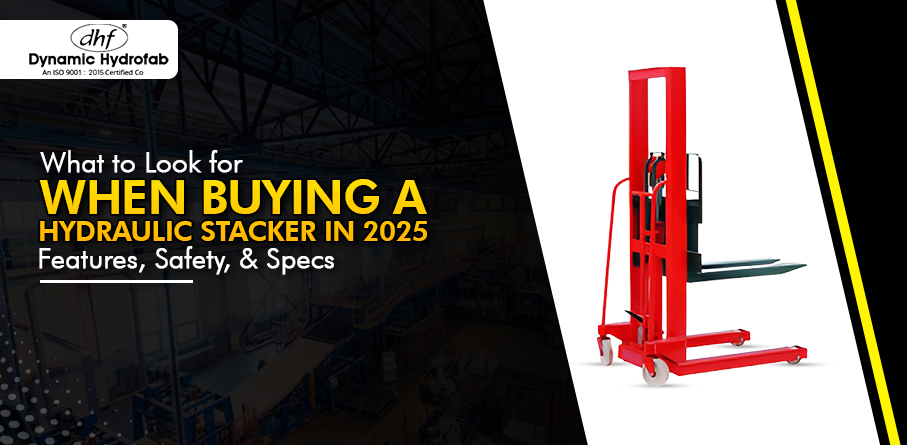- 195-B, Libaspur Road Samaypur, Delhi-110042

A Hydraulic Stacker is a good purchase for any company that deals with pallets, moves heavy things, or needs to safely stack things in small areas. There are many types of stackers on at Dynamic Hydrofab in 2025, ranging from simple manual hydraulic models to models that are partially or fully powered by electricity. The best choice will rely on the amount of space available, safety concerns, and the overall cost of ownership.
The first choice is the type of power. Dynamic Hydrofab’s manual hydraulic stackers are cheap and easy to keep up, making them perfect for light, occasional use. Semi-powered or electric stackers cost more up front, but they make work much easier for operators, lift things faster, and move more things through busy buildings. Electric models often have powered movement and lifting, which makes them better for jobs that need to be done over and over or for moving heavy things. Think about how many lifts you expect each day and whether speed or operator tiredness are issues. These issues often make the extra cost of a powered stacker worth it.
Know how much weight you can lift and how high you need to be to do it. Most light-to-medium stackers can hold between 1,100 lb (500 kg) and 2,200 lb (1,000 kg), and their lift heights are usually between 63" (1.6 m) and 96" (2.4 m) or more. Make sure that the rated load is valid at the load center and lift height that you need. Usually, capacity goes down as lift height goes up. If you work with different kinds of pallets, check the fork's length, thickness, and width setting. Always use maker spec sheets instead of pictures to compare.
Safety rules are important. Look for equipment made by Hydraulic Stacker Manufacturers that meets the regional and international safety standards for industrial trucks and stackers that can be handled by pedestrians, such as EN 1757 and related lifting and hoisting standards. It is important to keep records of things like emergency stop switches, overload safety, secure brakes, and guard designs. Following the rules lowers your risk of being sued, helps your insurance, and is often in line with local safety rules for the job. You can ask sellers for conformity statements or certificates.
Controls that are easy to use and comfortable lower risks and boost efficiency. Check the ergonomics of the handle, the pump effort (how many pumps it takes to reach full height), and how quick the steering is for manual stackers. For electric bikes, look at the throttle design, dead-man switches, speed control, and the screen or readouts that show the battery charge and trouble codes. When ergonomics are done right, workers are less likely to get tired, make mistakes, and get hurt over time.
Wheel type and chassis design are very important if you work in narrow hallways or on floors that aren't level. It's easy for nylon wheels to roll on smooth concrete, but they can be noisy. Polyurethane wheels keep the surface safe and stick better. When storing things on more than one aisle, you should think about the turning radius and total area. Some stackers have narrow-mast or adjustable straddle widths for tight areas, so make sure you know how wide your aisles are before you buy.
For electric Hydraulic Stacker machine, the type of battery and how it is charged are important. Traditional lead-acid batteries are less expensive, but they are heavy and need to be maintained and ventilated regularly. Lithium-ion batteries cost more at first, but they charge faster, last longer, and need less upkeep, which often lowers the total cost of ownership over time. Check the runtime, the charge time, and to see if the charger is built in or connected to the outside.
Check the quality of the build by looking at the mast, fork welds, hydraulic seals, and finish. Ask if spare parts and area service technicians are easy to get. A longer warranty on structural and hydraulic parts shows that the maker is sure of their product. Ask about recommended maintenance intervals and the expected total cost of ownership over five years. A cheaper purchase doesn't always mean a lower lifetime cost.
In 2025, picking the best Hydraulic Stacker means weighing the initial cost against comfort, safety, and long-term dependability. If you choose a machine from Dynamic Hydrofab that is right for your daily tasks, you'll save time, be safer, and get your money back faster.
Also Read:- What is a Hydraulic Stacker? Types and Applications
Leave a Comments